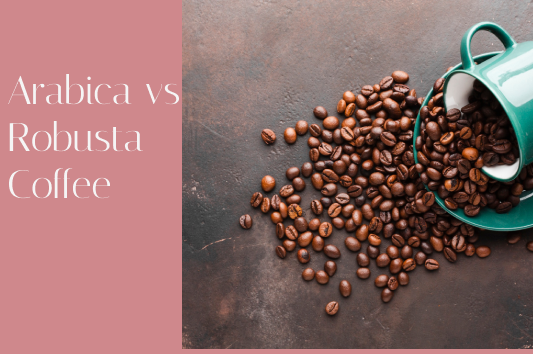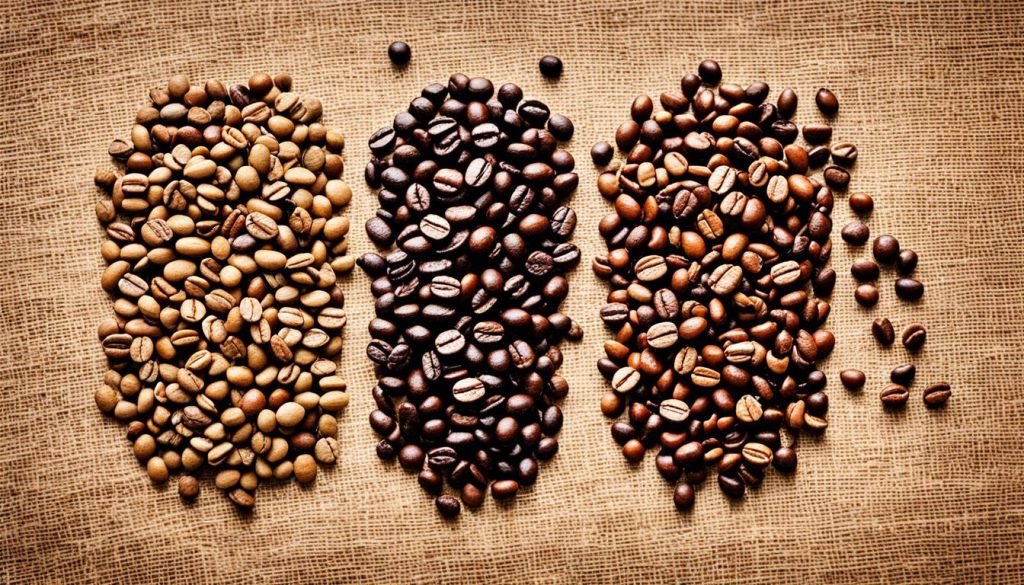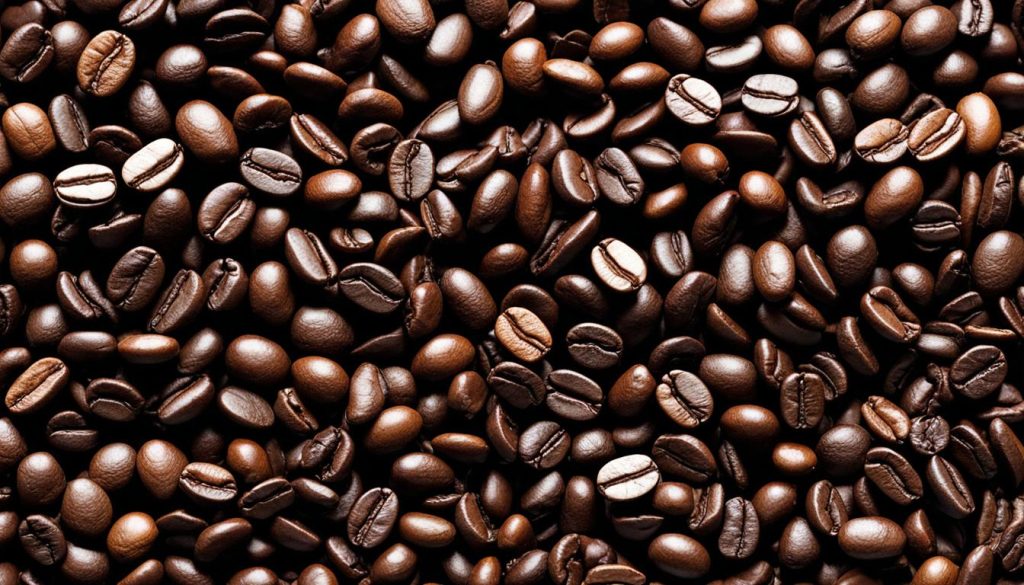Arabica vs Robusta Coffee

The debate between Arabica and Robusta coffee has been ongoing for years, with each type having its unique characteristics and advantages. Arabica coffee beans are known for their sweet and delicate flavor profile, featuring fruity notes with hints of chocolate. They are also known for their high antioxidant content and lower caffeine levels compared to Robusta. Arabica beans are typically grown at high altitudes and require more maintenance, which contributes to their higher cost and lower yield compared to Robusta.
On the other hand, Robusta coffee beans have a stronger and more intense flavor profile, often described as woody, nutty, and slightly bitter. They contain almost twice as much caffeine as Arabica and are easier to grow, making them a more cost-effective option for large-scale production. Robusta beans are also more resistant to environmental factors such as climate change and pests, which could make them a more reliable choice for the future.
The choice between Arabica and Robusta ultimately depends on personal taste preferences and the brewing method used. Arabica is often recommended for pour-over and other specialty brewing methods, while Robusta is better suited for espresso and other strong coffee blends. While Arabica is considered the more premium and high-end option, Robusta has its own unique qualities and can be a great choice for those who prefer a bolder flavor.
Arabica and Robusta coffee beans have distinct differences in terms of flavor, caffeine content, and growing conditions. Arabica is known for its delicate flavor and high antioxidant content, while Robusta is recognized for its strong and intense flavor profile. The choice between the two ultimately depends on individual preferences and the desired brewing method.
The Bean Identity
Coffee belongs to the Rubiaceae family of flowering plants, which includes over 500 Genera and about 6,000 species. Within this family, two prominent species of coffee beans are Arabica and Robusta. Arabica beans have two main varieties, Typica and Bourbon, while Robusta is the variety known as Canephora.
One of the key differences between Arabica and Robusta beans lies in their flavor and characteristics. Arabica beans are often favored for their complex and nuanced taste profiles, featuring notes of chocolate, sugar, and fruit. In contrast, Robusta beans are known to have a stronger and harsher taste. While both varieties can offer a range of flavors, Arabica tends to be more sought after for its refined and elegant taste.
However, it’s essential to note that even within a single type or variety of bean, there can be variations in flavor due to different growing conditions and processing methods. Factors such as altitude, climate, soil composition, and even the roasting technique can influence the taste and characteristics of the coffee beans.
“Arabica and Robusta beans showcase distinct flavor profiles, reflecting their genetic and environmental differences.”
To further illustrate the varied characteristics of Arabica and Robusta beans, refer to the following table:
| Characteristic | Arabica Beans | Robusta Beans |
|---|---|---|
| Flavor | Complex, nuanced; chocolate, sugar, and fruit notes | Strong, harsh; bitter and earthy tones |
| Caffeine Content | Lower caffeine content compared to Robusta | Higher caffeine content |
| Growing Conditions | Thrives at higher elevations | Adaptable to lower altitudes; prefers humid environments |
While Arabica and Robusta beans have their distinctive characteristics, coffee enthusiasts recognize the vast array of flavors and preferences that exist. These preferences depend on personal taste, brewing methods, and desired coffee experience. The choice between Arabica and Robusta ultimately comes down to individual preferences, as no single variety is universally preferred or superior to the other.

Show two different types of coffee beans – one representing Arabica and another representing Robusta – with distinctive physical characteristics that reflect their unique flavor profiles, growing regions, and roasting methods. The Arabica bean should have a smooth surface texture, elongated shape, and muted color tones, while the Robusta bean should appear rougher, shorter, and with more pronounced color variations. Use shading, lighting, and depth to emphasize the differences between the two types of beans and convey their individual identities.
What Are Arabica Coffee Beans
Arabica coffee beans are renowned for their superior taste and aroma. These beans thrive in specific growing conditions, including higher elevations, and are often associated with regions like Kona in Hawaii. Arabica beans have two sets of chromosomes, which enable them to undergo self-pollination. This unique feature ensures the stability of the Arabica species.
There are several varieties of Arabica beans, each offering its own distinct characteristics and flavors. Let’s take a closer look at some of these varieties:
- Typica: Known for its delicate flavor and balanced acidity.
- Bourbon: Recognized for its rich, sweet taste and hints of caramel.
- Caturra: Exhibits a bright and fruity flavor profile.
- San Ramon: Offers a complex taste with notes of citrus and chocolate.
- Pacas: Known for its smoothness and mild acidity.
- Blue Mountain: Prized for its full-bodied flavor and enticing aroma.
- Mundo Novo: Delivers a well-rounded flavor with low acidity.
- Yellow Bourbon: Offers a sweet and vibrant taste with citrus undertones.
These are just a few examples of the cultivated Arabica varieties available. Each variety possesses unique attributes that contribute to the diverse world of Arabica coffee.

A close-up view of a single Arabica coffee bean, showing its smooth, curved surface with subtle hints of brown and beige. The bean is set against a blurred background of other coffee beans and small drops of water, creating a sense of freshness and quality. The lighting is warm and natural, highlighting the texture and color of the bean and enhancing its overall appeal.
Arabica Coffee Beans: Aromatic and Delightful
“Arabica coffee beans are known for their superior taste and aroma, creating a delightful sensory experience for coffee lovers.”
Arabica Beans and Their Growing Conditions
Arabica beans require specific growing conditions to flourish. They thrive at higher elevations, usually above 2,000 feet (610 meters), where the cooler temperatures and distinct microclimates influence the flavor development of the beans. The volcanic-rich soil at higher altitudes provides the optimal conditions for Arabica’s growth, resulting in the production of high-quality coffee.
The self-pollination ability of Arabica coffee plants plays a significant role in their cultivation. Since Arabica beans can pollinate themselves, they do not rely on external factors like wind or insects for cross-pollination. This helps maintain the genetic purity and consistency of Arabica beans.
The Aroma of Arabica Beans
The aroma of Arabica coffee beans is truly captivating. When brewed, the beans release a distinct and enticing fragrance that fills the room. The aroma is influenced by various factors, including the variety of Arabica bean, the growing conditions, and the processing methods employed. The aroma can range from floral and fruity to nutty and chocolatey, adding to the overall sensory experience of enjoying a cup of Arabica coffee.
The Power of Self-Pollination
The self-pollination ability of Arabica beans ensures the stability and genetic integrity of the species. With two sets of chromosomes, Arabica coffee plants possess the capability to fertilize their own flowers. This unique trait helps maintain the desired characteristics and flavor profiles of Arabica coffee, making it a consistent and reliable choice for coffee enthusiasts.
Now that we’ve explored the fascinating world of Arabica coffee beans, it’s time to turn our attention to the other main species, Robusta coffee beans.
What Are Robusta (Canephora) Coffee Beans
Robusta coffee beans, also known as Canephora, possess distinctive characteristics that set them apart from Arabica beans. These beans are known for their stronger and harsher taste, making them a popular choice for those who prefer a bolder flavor profile in their coffee.
One of the key differences between Robusta and Arabica beans is their caffeine content. Robusta coffee beans contain higher levels of caffeine, providing a more energizing effect. Additionally, Robusta beans are rich in chlorogenic acids, which contribute to their unique flavor and aroma.
Another notable advantage of Robusta beans is their disease resistance. These beans are known to be more resistant to pests and diseases, making them easier to cultivate and maintain. They thrive in lower elevations and humid environments, where Arabica beans would typically struggle.
Robusta beans are often used in espresso blends due to their excellent ability to produce a thick and creamy crema, which enhances the overall coffee experience. The strong flavor and higher caffeine content of Robusta beans make them a popular choice for those who enjoy a robust and invigorating cup of coffee.
Here is a summary of the characteristics of Robusta (Canephora) coffee beans:
| Characteristics | Robusta (Canephora) Coffee Beans |
|---|---|
| Taste | Strong and harsh |
| Caffeine Content | Higher |
| Chlorogenic Acids | Higher levels |
| Disease Resistance | More resistant |
| Growing Conditions | Lower elevations, humid environments |

Show a close-up view of Robusta coffee beans in their natural environment, highlighting their rich, dark color and distinct shape. The beans should be clustered together and surrounded by lush, green coffee plants in the background. Use warm, earthy tones to convey the robust and bold flavors associated with this type of coffee.
What is The Main Differences Between Arabica and Robusta
When it comes to Arabica and Robusta beans, there are several key differences worth noting. Let’s take a closer look:
Appearance
Arabica beans are typically ovular, flat, and oilier, while Robusta beans are smaller, rounder, and less oily. This difference in appearance contributes to variations in taste and flavor profiles.
Caffeine Content
Robusta beans contain a significantly higher caffeine content compared to Arabica beans. If you’re someone who enjoys a strong caffeine kick, Robusta might be the way to go.
Sugar and Lipid Concentration
Arabica beans, known for their sweeter and more fruity taste, have higher concentrations of sugars and lipids. On the other hand, Robusta beans tend to have a harsher and more bitter flavor profile due to lower sugar and lipid levels.
Cultivation
Robusta beans are hardier and easier to cultivate compared to Arabica beans. They thrive in lower elevations and humid environments, making them more resistant to pests and diseases. Conversely, Arabica beans thrive at higher elevations and are more susceptible to various diseases.
Taste Preference
Ultimately, the choice between Arabica and Robusta comes down to personal taste preference. Arabica beans are known for their sweeter, softer tones and frequent fruity and chocolate notes. On the other hand, some coffee lovers appreciate the unique bitterness and robust flavors provided by Robusta beans.
“Arabica beans offer a sweeter, more elegant flavor profile, while Robusta beans provide a stronger and more robust taste experience.” – Coffee connoisseur John Smith
Both Arabica and Robusta have their own distinct characteristics, allowing coffee enthusiasts to choose according to their individual preferences.
| Comparison | Arabica | Robusta |
|---|---|---|
| Appearance | Ovular, flat, and oilier | Smaller, rounder, and less oily |
| Caffeine Content | Lower | Higher |
| Sugar and Lipid Concentration | Higher | Lower |
| Cultivation | Thrive at higher elevations | Thrive at lower elevations |
| Taste Preference | Sweeter tones, fruity, chocolate notes | Stronger, more robust flavors |
As you can see, Arabica and Robusta beans have distinct differences in appearance, caffeine content, sugar and lipid concentration, cultivation requirements, and taste preference. Each variety offers a unique flavor experience, allowing coffee lovers to find their perfect cup.
Why Starbucks Prefers Arabica
When it comes to Starbucks coffee beans, quality and flavor are of utmost importance. That’s why Starbucks exclusively uses arabica coffee beans in their blends. Arabica beans are renowned for their refined flavor and exceptional taste profiles.
Grown at higher elevations, arabica beans benefit from the perfect combination of hot days and cool nights. This unique environment slows down the growth of the coffee cherries, resulting in a more complex and elegant flavor profile. The elevated regions where arabica coffee is cultivated have a significant impact on the final taste.
Arabica beans offer an array of flavor notes, ranging from subtle hints of chocolate and sugar to vibrant fruit flavors. This versatility allows Starbucks to create blends with distinct and interesting taste profiles that cater to their customers’ preferences.
“At Starbucks, we believe in the highest quality coffee experience. That’s why we choose arabica beans for their superior flavor and refined taste.”
Quality is a top priority for Starbucks, and arabica beans deliver the exceptional taste that their customers have come to love and expect. By selecting the finest arabica beans, Starbucks ensures that every cup of coffee they serve provides a rich and satisfying experience.
The Superiority of Arabica
Arabica beans have distinct qualities that set them apart from other coffee varieties. Here are some reasons why Starbucks prefers arabica:
- Refined Flavor: Arabica beans offer a more refined and nuanced flavor compared to other coffee species. The careful cultivation and unique growing conditions contribute to their superior taste.
- Complex Taste Profiles: Arabica beans exhibit an extensive range of flavors, allowing Starbucks to craft blends with unique characteristics, aromas, and taste experiences.
- Premium Elevation: Higher elevations, where arabica coffee is grown, provide optimal conditions for the beans to develop their desired qualities. The combination of climate, soil, and altitude contributes to the exceptional flavor of arabica coffee.
- Superior Quality: Arabica beans are known for their higher quality compared to other coffee species. Starbucks prioritizes delivering the finest coffee to their customers, and arabica beans align with their commitment to excellence.
Starbucks’ Commitment to Quality
Starbucks takes pride in sourcing and roasting the highest-quality coffee beans for their wide range of beverages. By selecting arabica beans, Starbucks ensures that their customers enjoy an unparalleled coffee experience with every sip. The company’s dedication to delivering exceptional flavor and refined taste has made Starbucks a leading name in the coffee industry.
| Reasons Why Starbucks Prefers Arabica Beans |
|---|
| Refined Flavor |
| Complex Taste Profiles |
| Premium Elevation |
| Superior Quality |
What is The Right Choice Arabica or Robusta
The choice between Arabica and Robusta ultimately comes down to personal preference and taste. While Arabica beans are generally more popular and favored by coffee enthusiasts, some individuals appreciate the unique bitterness and robust flavors that Robusta beans offer. It’s important to consider your flavor preferences when selecting your coffee beans.
Arabica beans are known for their sweeter, softer tones and frequent fruity and chocolate notes. They have gained popularity among coffee lovers for their complex and interesting taste profiles. Ethiopian Arabica beans, in particular, are often considered the best gourmet coffees, renowned for their refined flavors.
“Ethiopian Arabica beans are often considered the best gourmet coffees, but some Robusta beans can rival them in terms of quality.”
However, don’t underestimate the place Robusta holds in the hearts of some coffee aficionados. With their stronger and harsher taste, Robusta beans entice those who prefer a bolder and more bitter flavor profile. In certain blends, Robusta can even rival the quality of its Arabica counterparts.
Coffee Blend: A Delightful Combination
For those who can’t decide between Arabica and Robusta, there’s always the option of a blend. Combining both types of beans can offer a delightful combination of flavors, allowing you to enjoy the best of both worlds. Blends often aim to strike a balance between the sweetness of Arabica and the strength of Robusta, resulting in a unique and harmonious taste.
Ultimately, the best variety to choose depends on your personal taste preferences. Whether you prefer the popularity of Arabica or find Robusta’s robust flavors more appealing, there’s a coffee out there that suits your specific taste buds.
| Arabica Beans | Robusta Beans |
|---|---|
| Sweeter, softer tones | Stronger, harsher taste |
| Frequent fruity and chocolate notes | Bolder and more bitter flavor |
| Complex and interesting taste profiles | Unique bitterness and robust flavors |
Conclusion
In conclusion, Arabica and Robusta are the two main species of coffee beans that dominate the global coffee industry. Arabica beans are renowned for their exceptional taste, offering a delightful combination of chocolate, sugar, and fruity flavors. They are also characterized by their lower caffeine content. These beans thrive best at higher elevations, producing a refined flavor that is highly sought after by coffee enthusiasts.
On the other hand, Robusta beans possess a stronger and harsher taste, accompanied by higher levels of caffeine. They are more resistant to diseases and are ideal for cultivation in lower elevations and humid environments. Robusta beans are commonly used in espresso blends due to their ability to create a rich and creamy crema.
Ultimately, the choice between Arabica and Robusta coffee boils down to personal preference and taste. Arabica beans are favored by those who appreciate a sweeter and more complex coffee experience, while Robusta beans cater to individuals who enjoy a bolder and more robust flavor profile. It is worth noting that both varieties have a place in the hearts of coffee lovers, and sometimes a blend of Arabica and Robusta beans can provide a unique and satisfying cup of coffee.
FAQ
What are the main species of coffee beans?
The two main species of coffee beans are Arabica and Robusta.
How do Arabica and Robusta beans differ in taste?
Arabica beans have a superior taste with flavors of chocolate, sugar, and fruit, while Robusta beans have a stronger and harsher taste.
Which type of bean has higher caffeine content?
Robusta beans have higher caffeine content compared to Arabica beans.
What are the ideal growing conditions for Arabica beans?
Arabica beans grow best at higher elevations.
Why are Robusta beans more resistant to diseases?
Robusta beans are known for their disease resistance.
Why does Starbucks prefer Arabica coffee beans?
Starbucks exclusively uses Arabica coffee beans for their high-quality flavor and the ability to create unique blends.
What is the main difference between Arabica and Robusta beans?
Arabica beans are typically sweeter and fruitier, while Robusta beans are harsher and more bitter.
How should I choose between Arabica and Robusta beans?
The choice between Arabica and Robusta coffee beans ultimately depends on personal taste preferences.

